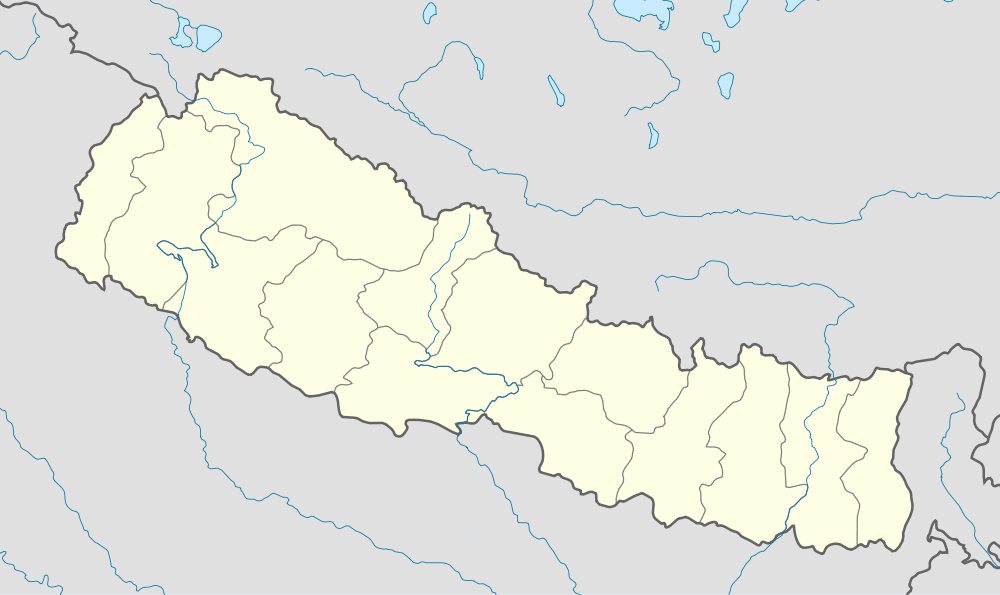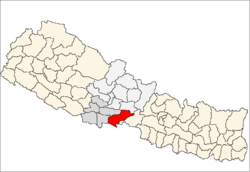Sunwal
| Sunwal सुनवल नगरपालिका | |
|---|---|
| Municipality | |
 Sunwal Location in Nepal | |
| Coordinates: 27°38′N 83°39′E / 27.63°N 83.65°ECoordinates: 27°38′N 83°39′E / 27.63°N 83.65°E | |
| Country |
|
| Zone | Lumbini Zone |
| District | Nawalparasi |
| Population (2011) | |
| • Total | 39,850 |
| Time zone | NST (UTC+5:45) |
| Website |
www |
Sunwal (Nepali: सुनवल) is a municipality in Nawalparasi District. It lies in Western Development Region, Lumbini Zone. It was announced as a municipality on 2011 combining two neighboring Village Development Committees; Sunwal and Swathi; of the district (by means of financial plan for the fiscal year 2011-2012 on July 16, 2011). It is the urban core of a rapidly growing urban agglomerate in Nepal. Sunwal is one of the biggest and the richest Municipality of Nawalparasi district. Recently, it belongs to the State no.5 under new constitution.
Sunwal Municipality is the first Child Friendly municipality of Nepal.
Demographics
At the time of the 2011 Nepal census it had a population of 39846 people living in 8639 individual households. After the announcement of Municipality by combining two VDC's, the total population of Sunwal Municipality becomes more than 60,000, which is highest in Nawalparasi district. Swathi alone had population of 10629 with 2102 individual households at the time of the 2011 Nepal census.[1][2]
Sunwal consists of people of mixed groups and castes; these include Pahari immigrants from nearby hill districts especially Palpa, Arghakhanchi, Parbat, Gulmi, Syangja and others and people of Terai origin. Hindus in the majority celebrate Holi, Teej, Maha Shivratri, Dashain, Tihar and Bhai Tika.
There are also Buddhist and Muslims. There is a very good and harmonious relationship among different religious and ethnic community which can be seen during festivals.
Nepali and English is the common language spoken in Sunwal. Gurung, Magar, Newar and Tharu people speak native language in their community.
English is not used much; however, most of the young generations and mid aged population can communicate well in English.
Economy

The economy of Sunwal centers around trade, services and industries. Numerous wholesale and retail shops sell Chinese and Indian goods in these markets. Besides mordern shopping, a traditional form of market called Haat Bazar runs twice a week on Sunday and Tuesdays in Sunwal Bazar and Naduwa Bazar respectively. Usually, farmers directly sell to the retail customers in this market in a dusty and busy market setup.
Nepal's one of the largest Sugar factory, Lumbini Sugar Industry, which was made by China's support, also lies here. Lumbini Sugar Industry is also one of the most famous place for which this city is known for. Many international tourists (especially Chinese) and internal visitors come here for the industrial and educational visit. Sunwal also has other small, medium and large scale Industries. Other large scale industries such as Laxmi Steels Factory, Butwal Cement Industry etc. are also located here. 3 distilary factories are also running here. Many small and cottage industries are also doing its operations.
Service based economy is centred around banking and education. Increasing number of people are involved in jobs in these sectors. About a dozen of banking and financial institutions are operating here. More than 2 dozens of co-operative societies are also playing great role in increasing the financial and investment opportunity among stakeholders and upliftment of rural areas.
Sunwal is also the urban core of an upcoming urban agglomerate comprising the nearby municipalities of Devdaha, Ramgram, Bardaghat and VDCs such as Ramnagar(Bhumahi). Together, these make up an urban continuum and the region as a whole has an increasingly large contribution to the national economy. Ramgram is headquarter of Nawalparasi and near to international border and customs point with India at Maheshpur and connected to Siddharthanagar through Bhumahi-Bhairahawa By-Pass Road. Bardaghat is also a municipality formed recently and is the gateway to the Religious and tourist site, Triveni. Devdaha is an emerging city in Rupandehi district.
Sunwal is also a city, which is connected to nearby tourist areas of Ramagrama stupa, Triveni, Tansen, Kapilvastu and Lumbini. It is also the gateway to nearby cities of Butwal, Ramgram and Bharatpur.
Transport
Gautam Buddha Airport located in Siddharthanagar is the nearest airport from Sunwal connecting to Kathmandu. It has regular flights to Kathmandu. It is also in construction phase for the upgradation into regional international airport. One can go to Siddharthanagar from Sumwal through Sunwal-Parasi-Bhairahawa road.
Sunwal Municipality is connected with Mahendra Highway. Mahendra (East West) Highway connects Sunwal to Kankarbhitta in the east to Bhimdatta (formerly Mahendranagar) in the west of the country. Tanka Prasad Acharya Marga, (which connects Sunwal to Ramgram Municipality (Parasi, the headquarter of Nawalparasi district) is also one of the important highway. Sunwal is connected to Palpa district by new developing road tranport called Sunwal-Gothadi Marga. Sunwal is 21 km east of Mahendra Highway from Butwal Sub-Metropolitan Municipality.
Buses are the dominant form of transportation. Private operators offer service to various destinations that departs from butwal, is available here. Since 2003, operators have added newer minibuses popularly called micro, for local transport service having routes Butwal-Sunwal-Bardaghat. Older jeeps are used to take people to nearby hilly regions. Rickshaws are used for short-distance urban transport, however E-rickshaw (ई-रिक्सा) is also introduced here from 2014 for city area. Motorcycles are a common means of personal transportation around town.
Madhya-Nepal Transport Association, Sunwal is the operator of transport services based in Sunwal and operates its services to different regions of Nawalparasi and rupendehi district such as Sunwal-Parasi, Sunwal-Parasi-Maheshpur, Sunwal-Parasi-Bhairahawa, Sunwal-Parasi-Triveni, Sunwal-Mahalpokhari. Its head-office is in Sunwal and branch offices in different cities.
- Intracity: Cycle, rickshaws, and Electric Rickshaw serve the city center. City safari or electric rickshaws are the most used transportation here, which connects all part of Sunwal and is very cheap.
Education


There are many public and private secondary and higher-secondary schools. Some campuses are also established for different bachelor-level programmes. The major schools and colleges are as follows:
Higher Secondary School
- Mahakabi Devkota Higher Secondary School
- Lumbini Higher Secondary School
- Somnath Baba Higher Secondary School
- Sakura Higher Secondary School
- Janasewa Higher Secondary School
Colleges
- Mahakavi Devkota Campus
- Somnath Baba Campus
Places of interest
- Mahalpokhari
Mahalpokhari is located 11 km north of Sunwal municipality at the border of Palpa and Nawalparasi district. It is the beautiful place of Sunwal, at the hilly area and cool breeze flows every day and night. There is a pond which is surrounded by hills from all sides named Mahalpokhari from which the name of the place is derived. There is the small village also. There is a Temple at peak point of the hill from where we can observe the scenery view of Sunwal, Devdaha, Palpa, Bardaghat and Parasi. Daily jeep departs from Sunwal to Mahalpokhari. But most of the people hike to the place onfoot.
- Belayari Village
It is a beautiful village of magar community, 3 km north from Sunwal. Mostly houses are made up of woods and stones which resembles the community at Mustang. It is on the bank of Turiya river. Most of the people depend on agriculture. The people are very friendly and co-operative.
- Somnath Baba Temple
It is the temple of Shiva located at the Naduwa Tol where people of different places come to worship. It is one most sacred region of Sunwal.
- Pragati Bal Uddhan
It is a park where there are two temples of Lord Shiva and Devi Durga located at Somnath. There is a park and playground for children under construction. Many people come here to roam around in the peace environment.
Nearby tourist attractions
It is a stupa located in Ramgram Municipality, some 11 km far from Sunwal. The regular jeep and bus goes from Sunwal. This Buddhist pilgrimage site, which was constructed some 2500 years BCE, contains relics of Gautama Buddha.[3] According to Buddhist texts, after Buddha's Mahaparinirvana, his cremated remains were divided and distributed among the princes of eight of the sixteen mahājanapadās. Each of the princes constructed a stupa at or near his capital city, within which the respective portion of the ashes was enshrined.[4] One of them was Rāmagrāma, a major city of the Koliya kingdom (this settlement is sometimes referred to as Koliyanagara) at that time.[5][6]
Some 300 years later, Emperor Ashoka opened seven of these stupas and removed the Buddha relics (his goal was to redistribute the relics into 84,000 stupas which he planned to construct throughout the Maurya Empire). According to legend, the Naga serpent king was guarding the Ramagrama stupa, and prevented Ashoka from unearthing the relic.
To this day, Ramagrama stupa remains the only intact and original stupa containing relics of Lord Buddha.[3] The stupa has been an object of great reverence and pilgrimage site since its original construction. The 7 metres (23 ft) high stupa is now buried under a mound of earth and is awaiting further research.[4]
- Devdaha
The historical and religious site of Nepal situated 6 km west of Sunwal, is best known for the maternal home of lord Gautam Buddha. It is a place of best natural beauty and pollution free environment. Kheirani, Bhawanipur, Bairimai, Kan yamai, Khayardanda etc. are the places of interest. Aap Khola' (mango river) where people go for swimming and to obtain water during droughts. There is a view of nearby Manakamana Temple.
- Manimukunda Sen Park (Phulbari)
The winter palace of Palpali Sen clan is very fascinating from natural and archaeological values. There are ruins and antiquities of the majestic palace of Manimukunda Sen an ancient Palpali king containing 6 large rooms as well as royal residence, administrative and fascinating scenic grandeur of Butwal, Siddharthanagar and other neighbouring villages of Rupandehi district can be vividly seen from here at night also. His Majesty's Government, archaeological department has attempted to maintain it in 1991. Now Butwal municipality has formed council for the conservation of Manimukunda Sen Park to conduct Phulbari Development Programme and attempted to make it an amusing and a tourist resort.
- Siddha Baba Temple
It is located on hills at the border of Butwal Municipality.[6] Devotees believe that Siddha Baba will grant their wishes and offer pigeons at the temple. On Saturdays, the weekly holiday in Nepal, large number of devotees visit this temple and special Microbus services are offered.
- Tribeni Ghat on the Narayani River (known as Gandak in India) is an auspicious site for bathing. It attracts hundred thousands of pilgrims on Maghe Sankranti (Hindi: Makar Sankranti), approximately 15 January.
- Valmiki Ashram near Tribeni Ghat, believed to be the place where Prince Siddhartha got down from his horse Kantaka and strode off on foot and into the jungles in his search for answers.
- Chitwan National Park east of the Narayani River, a preserve larger than 900 km2 protecting some 700 native animal species—including gaur, tiger, rhioceros, gharial and crocodile—and flora native to the Terai-Duar savanna and grasslands.
See also
References
- ↑ "Nepal Census 2011". Nepal's Village Development Committees. Digital Himalaya. Retrieved 18 December 2008.
- ↑ Central Bureau of Statistics of Nepal: National Population and Housing Census 2011
- 1 2 UNESCO (2014). "Ramagrama, the relic stupa of Lord Buddha". Tentative Lists. Paris: UNESCO World Heritage Centre. Retrieved 2014-11-30.
- 1 2 Shrestha, SS (1999). "Ramagrama excavation" (PDF). Ancient Nepal: Journal of the Department of Archaeology. 142: 1–12. Retrieved 2014-11-30.
- ↑ "Rāmagāma". Palikanon.com. Retrieved 2015-05-16.
- ↑ "Koliyā". Palikanon.com. Retrieved 2015-05-16.
External links
| Wikimedia Commons has media related to Populated places in Nepal. |
- Cost of Living Index in Nepal - Statistics & Graphs of Nepalese Citizen's Economic Power, January 10, 2014
- Central Bureau of Statistics, Final result of population and housing - census 2011, VDC/Municipality, Table 2 (p. 8)
